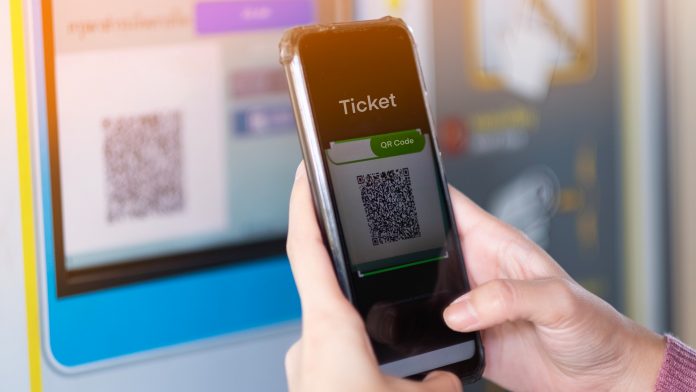As smart tickets are increasingly being used by travellers across Europe the Smart Ticketing Alliance is working to ensure co-operation between the various schemes across the continent.
Smart tickets provide travellers with a quick and convenient way to pay for their journey, as well as providing transport companies with vital data for network planning. However, as their use grows in Europe, establishing an interoperable system across countries is key.
The Smart Ticketing Alliance was founded in 2015 as the follow up to the EU-IFM (European Interoperable Fare Management) Project, which was funded by the European Commission under the 7th Community Framework Programme for Research and Technological Development.
It is a non-profit organisation which aims to promote and establish interoperable smart ticketing in all transport services across Europe. It aims to ensure co-operation between the electronic ticketing schemes in different countries to enable seamless travel and it is working on solutions to develop interoperability using existing technologies.
The Smart Ticketing Alliance works closely with the European Commission and focuses on governance, as well as looking at technical solutions to cross-border travel.
Its Vice Chairman Nils Zeino-Mahmalat spoke to the Innovation Platform’s Managing Editor Michelle Gordon about promoting and facilitating co-operation between national and regional smart ticketing schemes.
What exactly is a smart ticket and what are the benefits of using them?
Smart ticketing started with smart cards, which are still used by the vast majority of passengers in big cities. Over the last year or so, there has been an increase in the use of tickets on smartphones; but while smartphone ticket usage continues to increase, uptake is not as fast as we had expected.
The key benefit in using smartcards is convenience for the passenger, especially when using smartphones which allows ticket use to be combined with journey planning. You can look on your smartphone to see how to get from A to B and your ticket is available at the touch of a button. It is also more convenient for ticket inspections, making the whole process quicker.
Another huge benefit is interoperability. The travel systems in many European countries are fragmented, with different tariff systems in the same city between different operators. There are also big differences from region to region and when you cross borders throughout Europe, so it is not very seamless from the paper ticket perspective. Smart ticketing can solve these problems because the system is automatic, so passengers don’t have to struggle with complicated tariff systems.
Is smart ticketing more widely used in some countries than others?
You find smart ticketing in every country in Europe, delivered in different ways. In the Nordic countries, for example, much of the smart ticketing utilises smartphones, while other countries use more smartcards.
The Netherlands has introduced a single nationwide electronic ticketing system based on a smartcard. This means that it is possible to use a smartcard at every bus stop and every train station within the Netherlands.
In many large metropolitan areas with big transportation systems, such as London, there are gates at the stations. As such, the focus of the Oyster Card, for example, is also on managing the large numbers of people entering the station within a few seconds.
In Germany, however, there are no gates at the stations; not even in Berlin. The vast majority of public transport passengers in Germany are subscription ticket holders and a monthly fee is taken from their bank accounts by Direct Debit for travel. They simply have a smartcard which they use for travel and ticket inspections.
Smart ticketing thus has a different meaning in Germany than in some other countries, but you find smartcards in every big city, from London to Lisbon.
How much of a challenge is the issue of security/data protection when using smart tickets and how difficult has that been to overcome?
Data protection and privacy is a very big issue. It is important to ensure that there is no fraud and no copying of tickets. Most tickets on smartphones are 2D barcodes which can be copied, so when ticket inspections are carried out passengers must also show a form of ID, which makes the process very slow. Simply holding a smartcard to a card reader only takes a second, but having to ask for and check an ID card can take a few minutes, so there is a challenge to be overcome there.
Starting in Germany next year, a copy protection technology for 2D barcodes is being launched which will generate barcodes from a secure, crypto environment. These will be linked to individual smartphones and if they are copied to another smartphone they will not work. I hope this will help us to increase smart ticketing use on smartphones within the next year or so within Europe, as well as improving the ticket inspection process and preventing ticket fraud.
Data management and security is also key. When a ticket inspection is carried out, there is a transaction between the terminal and the smart card and data is transferred to the office to check that the card is valid. Our challenge is to ensure that the personal data that is collected through smartcards is kept safe and that card users cannot be identified. For example, I am the Managing Director of a German scheme and we have an end-to-end encryption, so when I look on the system at our list of active cards, I cannot see any details about the card’s owner – that is encrypted.
How can the data that is gathered through smart ticketing be used to help ensure that there is adequate transport provision in the future and for network planning?
It is already used for network planning and to see if the planning is working in practice. Smartphone systems supply valuable data about the routes taken and you can see how people are moving and can calculate costs. With a tap-in, tap-out system like you have in London, you can see how many passengers are on a Tube line at any one time, and you can see exactly how people are moving and at which station they change from one line to another. This is all useful information for route planning, and operators can see if passengers travelling from Station A to Station C are changing lines at Station B, for example, as expected, or if they are taking alternative routes.
Do you anticipate a growth in the use of smart ticketing over the next few years?
There are still many paper tickets being used in Europe but I think that number will start to fall and we will see an increase in the use of smartphone ticketing, with smartcards continuing to be used at largely the same rate as before.
Some operators say smartphone ticketing will increase by 10% a year, others say 20%; but it is not clear whether these figures refer to the number or value of tickets.
COVID-19 has, of course, had a huge impact on public transport across Europe. For example, revenue is down by 30% in Germany and the federal state has had to invest billions of euro to stabilise the market. Nobody knows how public transport will develop after the pandemic, so we will just have to see what happens next year.
Are there any barriers to the adoption of smart ticketing that you think need to be overcome in order to get more people using them?
If you make a good product and make it easy to use, then people will use it. As such, I think we need to focus on useability rather than the performance of the technology. The technology is already developed, but some of the apps that have been developed by operators are not very user friendly.
From our perspective as operators, we have to drive interoperability forward and improve standards, and we have to work together to ensure that systems across Europe are harmonised. For example, within the Small Ticketing Alliance, we have a Working Group, which is building a glossary to make sure that when a term is used, the definition is the same across different countries. So, what is a ticket? What is an entitlement? What is an application? What is a certificate? These are things that we have to work on to make it easier for the suppliers to make good products.
Furthermore, the public transport sector must work collectively to ensure that there is a level playing field for suppliers in terms of bringing technology forward, so that they have the opportunity to provide their products to a fair market at fair prices, and that the market is not monopolised by large international tech firms.
What will be the main areas of focus for you as an alliance next year and beyond?
We have to work on harmonising the standards, and we will also place a particular focus on harmonising the governance of electronic ticketing schemes so as to make cross-border travel easier. For example, in Germany all public transport operators are under one governance umbrella, from a single organisation, so everyone is on the same level and every operator knows that they can trust the governance. But that situation does not yet exist at the European level, and if people do not trust the governance framework, they will be reluctant to work together on a technical level because they will be worried that it may be not fair. So, trust is a key issue, and this will be one of the main points we will work on over the next few years, especially as markets are changing.
Will Brexit have any impact on harmonisation and smart ticketing across borders?
I hope not. The Smart Ticketing Alliance is keen to continue working with the United Kingdom, especially as our chairman is British and we are working well together. I do not think Brexit will affect us too much, although it might make things a bit more difficult, as the Smart Ticketing Alliance works closely with the European Commission to understand the political strategy at a European level and how that can be adopted into our work. The work of the STA will thus remain EU-focused, but if the main strategy for the EU fits with the UK Government’s strategy, then there should not be too many problems.

Nils Zeino-Mahmalat
Vice Chairman
Smart Ticketing Alliance (STA)
niz@smart-ticketing.org
www.smart-ticketing.org
Please note, this article will also appear in the fourth edition of our new quarterly publication.







